Check out this comprehensive guide full of professional tips for intermediate and advanced aquarists looking to add the freshwater oddball, Erpetoichthys calabaricus, to their community or niche-specific aquarium.
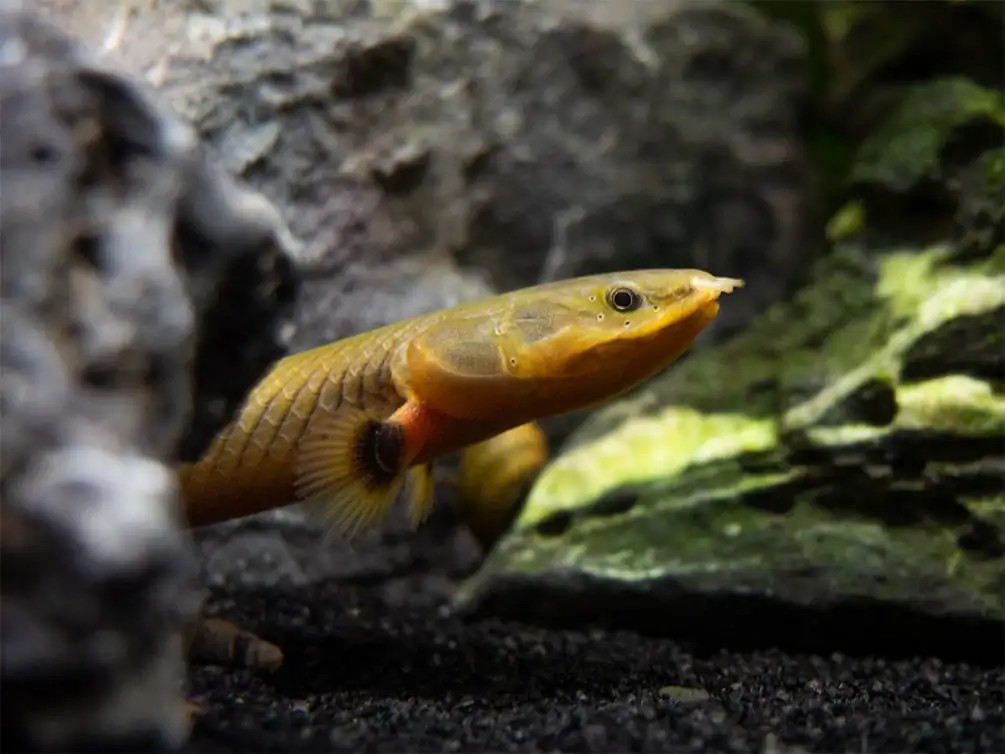
Reedfish / Ropefish: Ancient, Air-Breathing Curiosity
In a sea of oddball aquarium fish species, the nocturnal bottom dweller, Erpetoichthys calabaricus, stands out. It’s a snakelike fish that grows between 20–36 inches (~50 – 90 cm) and has an eel-like look that earned it the nicknames, Ropefish and Reedfish.
As a West/Central African native, this species has a lung-like body feature along its gills for surviving its natural environment’s low-oxygen waters.
In this ropefish care guide, you’ll learn about the physical and behavioral aspects of this species to help you understand its needs.
Now that you’ve had an Erpetoichthys calabaricus intro, let’s start this reedfish overview with a look at its natural habitat.
Author’s Note: Check out our post on The 13 Freshwater Aquarium Eels That Can be Kept as Pets for even more eels!
Natural Habitat & Survival Adaptations
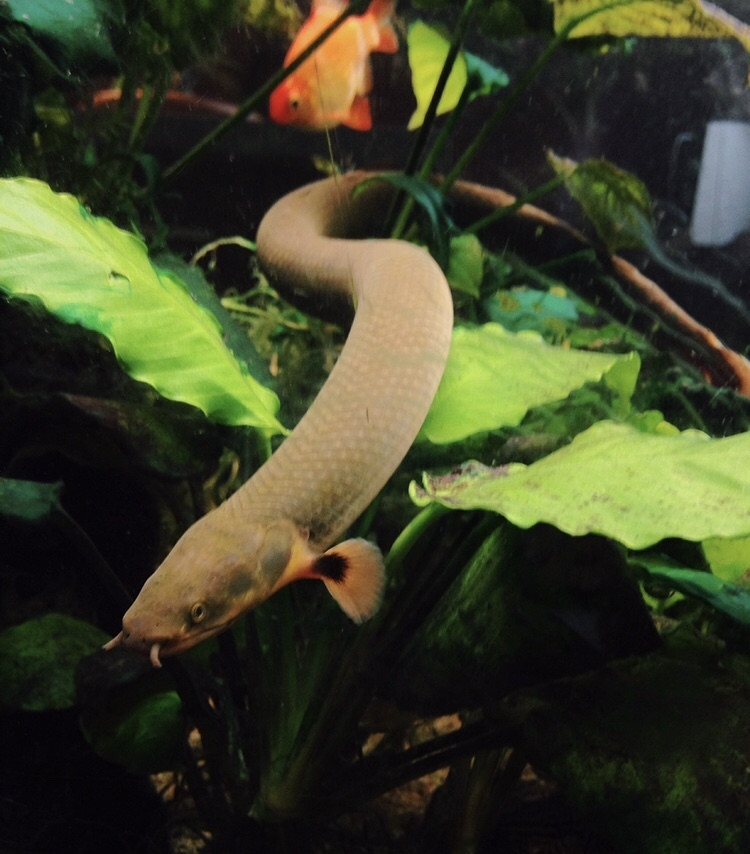
You’ll find Reedfish in the African freshwater swamps, particularly in the Ouémé and Sanaga Rivers of Nigeria, Cameroon, and the Benin Republic. This reedfish’s habitat typically has slow-moving waters and low oxygen.
Because of its natural low-oxygen environment, this species developed an air-gulping fish behavior for tolerance. It also has a primitive lung behind its gills that aids this behavior. Other aspects of the ropefish’s wild environment include muddy substrates, aquatic plants like reeds, hence the name, and warm water temperatures.
Before getting into the details of designing an ideal habitat, you must first understand how to distinguish ropefish from other species.
Recognizing the Species & Size
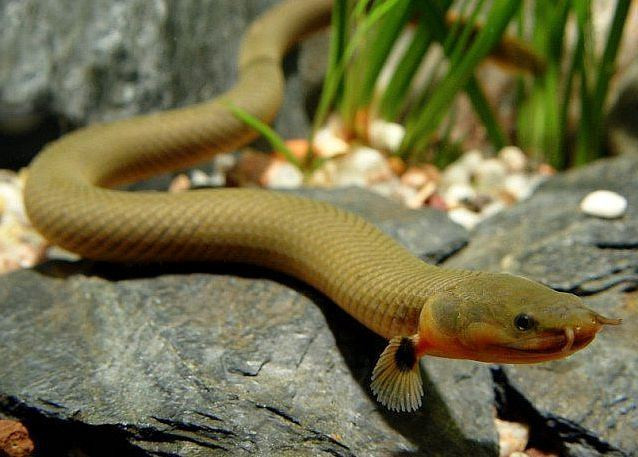
Ropefish/Reedfish are an elongated freshwater fish descended from the Bichir species. At maturity, this species can stretch approximately 20 – 36 inches (~50 – 90 cm). Despite the reedfish’s size, it only has small dorsal finlets behind its head for propulsion.
Its snake-like/rope-like prehistoric appearance sometimes makes identifying ropefish challenging. So, you have to use these other Erpetoichthys calabaricus features for identification:
- Thick, Bony scales
- Flattened head with thick whiskers
- Lung-like features, which are a modified swimming bladder
- Dark brown or olive green back and light yellow underbelly.
These two-toned colorations favor the Reedfish in the wild by camouflaging it with the environment to hide from predators.
Now, let’s recreate these features for an ideal aquarium setup.
Aquarium Setup & Decorations
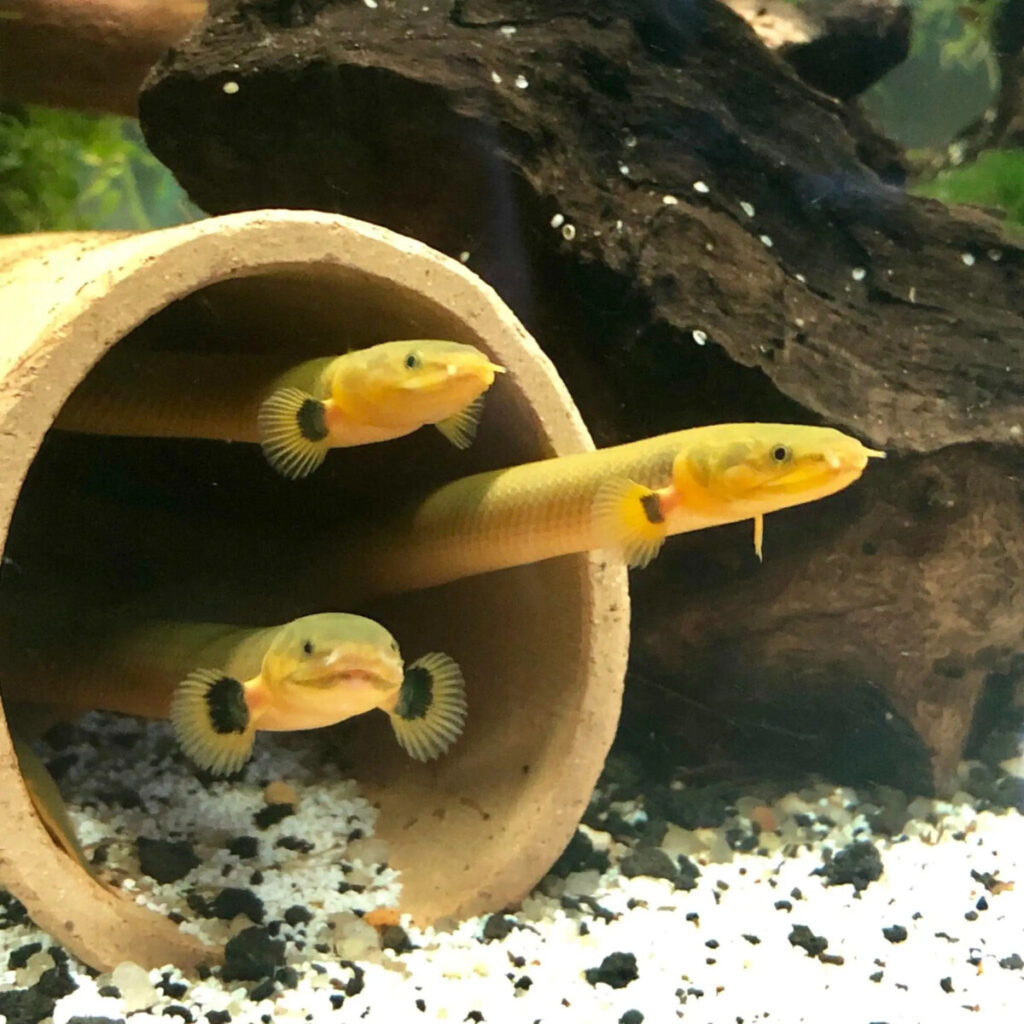
Because of its 20 – 36” length, an ideal ropefish tank setup would start with a 50–75+ gallon long tank. Once you settle on a horizontal tank container, you can now build up on it with the right decorations.
We’ll start our naturalistic oddball tank design from the ground up. Base the substrate with soft materials like fine sand, then add specific reedfish aquarium décor.
Place caves with smooth surfaces around the tank for hiding and to create slits. Then add silky artificial or live plants with reed leaves for a realistic effect.
As you move upwards, you’d need to use these escape-proof aquarium tips to keep these jumpers at bay. Cover the water top with floating plants like frogbit and use a secure, tight-fitting lid to cover the tank.
Once you secure the hardscaping and container, the next focus is setting ideal water parameters.
Water Parameters & Maintenance
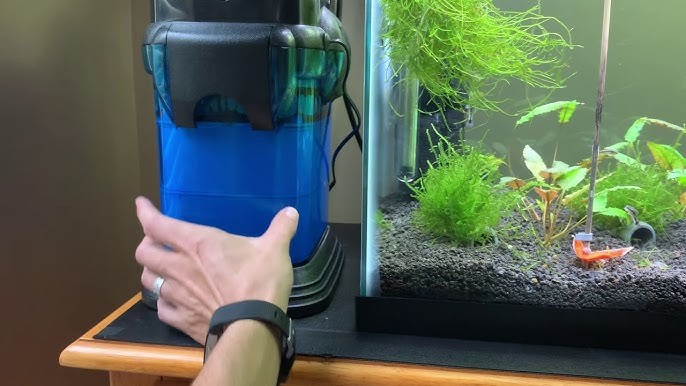
Penn-Plax Cascade All-in-One Aquarium Canister Filter
Found On Amazon
Designing is only one part of your tank setup. Think of it as the hardware, while setting proper reedfish water conditions is the software.
For this freshwater oddball care, set the following parameters to create an environment that’s similar to the still, African muddy waters.
| Temperature | 75–82°F |
| pH Level | 6.0–7.5 |
| Hardness | 5 – 20dKH |
Once you set the parameters, you must stabilize them with routine ropefish tank maintenance. Ensure the water current is gentle or still, and make frequent changes of 25-30% weekly to keep it pristine.
Because Ropefish is sensitive to poor water quality that dwells at the bottom, a substrate-focused cleaning routine is ideal. Use a reliable filtration system and routinely vacuum the sand to ensure the environment stays clean especially after feeding.
Author’s Note: Checkout the post on The 7 Best Aquarium Canister Filters Reviewed (2024) for an in-depth guide on choosing the right filter for your aquarium!
Diet & Feeding Habits
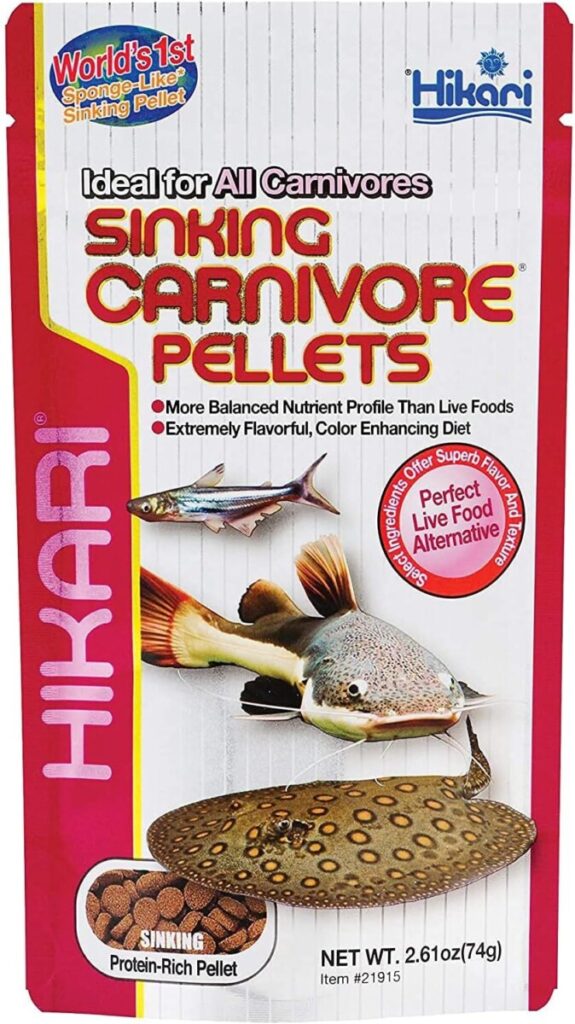
Sinking Carnivore Pellets for Pet
Found On Amazon
As a species that comes alive at night, these nocturnal fish feeding tips would provide them with nutrition during peak activity hours.
If you’re wondering what to feed Reedfish, it’s simple. As a carnivorous species, Reedfish eats live food like worms, shrimps, and fish fillets. You can also add specific pellets to your Reedfish diet plan if you train your pets to eat them.
Understanding their diet and making a plan isn’t the end of this Ropefish feeding guide. You must also create a suitable feeding and maintenance schedule to accommodate their nocturnal habits and protect their sensitive scales.
Reedfish, being nocturnal, should ideally be fed in the evening or right before you go to bed. While some owners have successfully conditioned them to eat during the day, feeding at night is generally recommended. And also only feed them enough food that they can consume within a feed minutes without much left over waste in their tank.
Compatibility & Tank Mates
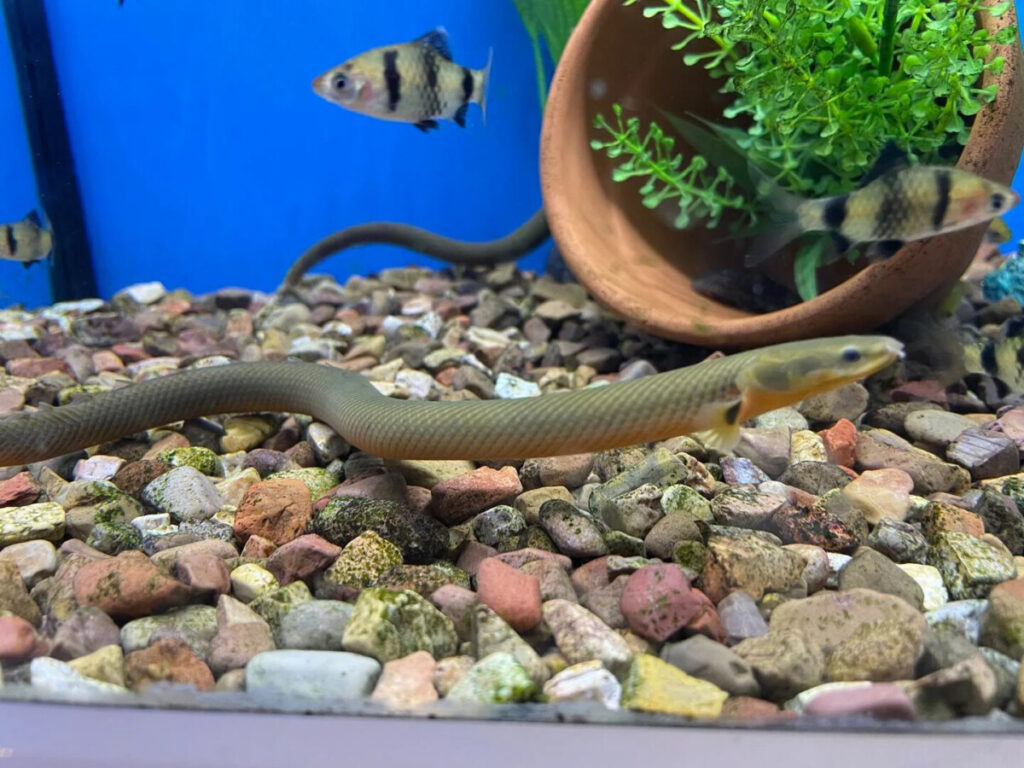
There aren’t many non-aggressive predatory species, which is why Reedfish is a special breed. This peaceful oddball fish won’t disturb other large species, but would take advantage of very small tank mates.
So, let’s highlight ideal Reedfish tank mates that won’t fall prey to your pet’s carnivorous appetite.
Medium to large-sized fish are the most compatible fish for Ropefish.
Specific examples for your Ropefish community tank include large Tetras, Angelfish, Rainbow Sharks, Bala Sharks, Pictus Catfish, and Gouramis. They can swim together with your Ropefish without getting territorial or mistaken for prey.
On the other hand, very small tank mates like shrimps and small tetras are incompatible with their sizes, and cichlids are not ideal because of their aggressive behavior.
Common Health Risks & Prevention
When it comes to this freshwater oddball fish’s health, creating an ideal environment is the foundation for giving it a good life. Next up is ensuring your pet eats a proper carnivorous diet for complete nutrition to avoid common ropefish diseases.
That’s because these diseases come from untreated cuts from sharp decor, parasites in contaminated water, or reaction to copper meds, which are all symptoms of poor Reedfish health care.
When you feed this species with a nutritious diet, you strengthen its immune system. Here are some extra parasite prevention tips to help keep the environment clean and healthy:
- Avoid overcrowding. Keep one Ropefish per 50-75 gallon tank.
- Quarantine new fish before adding them to the tank.
- Make regular water changes
- Maintain stable water parameters
- Consistently filter the water with deep substrate cleaning
- Add a small amount of aquarium salt to the water to keep it fresh.
Key take away from this section is to maintain proper and stable water parameters, without this the tank’s water quality can degrade, which can cause a wide range of issues from cloudy aquarium water to illness and mass die off.
Lifespan & Keeper Commitment
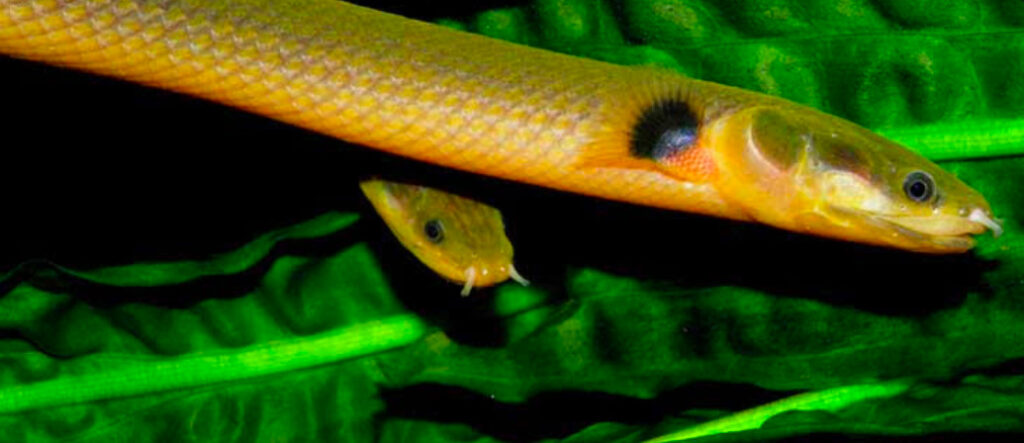
Enthusiasts typically recommend keeping oddball fish for advanced keepers because of their sensitive needs and potential lifespan.
With proper care, you can maximize a reedfish’s lifespan for 10 – 15+ years! So, choosing this species is admitting that you’re ready to invest in Ropefish long-term care practices.
Although you can start juveniles in small tanks, with time, they outgrow the enclosure and need larger mid-sized to maximum-sized tanks.
Scroll up for details on specific Erpetoichthys care practices, including tank setup, dietary needs, and compatible tank mates.
Conclusion: Is the Reedfish Right for You?
With the Ropefish aquarium advice in this guide, you can now decide if it’s the right species for you.
Although Reedfish/Ropefish is one of the best species for keepers wanting a unique prehistoric look, it’s not a beginner’s oddball fish choice.
This unique eel-like fish is peaceful and would make a perfect centerpiece in a community aquarium, but there are contingencies to ensure success.
Ropefish/Reedfish has so many specific care needs that only advanced and intermediate keepers can handle flawlessly.
So, if you made this exotic freshwater pet choice, ensure you’re ready to give it your all!


